► First UK drives of the Land Rover Defender 90 and 110
► Highly capable 4x4s are brilliant on- and off-road
► Is it good enough for Defender die hards? Does it need to be?
Pity poor Land Rover. Just days before the wider world's media got it hands on one of its most important new cars in years, the world went into lockdown, and everyone's attention was diverted to rather more pressing matters. The frustration at JLR's Coventry HQ must have been enormous – knowing it's sitting on its best products in a generation, and very few people were actually going to find out exactly how good they were.
Fast forward into the second hald of 2020 and with Defender sales already ramping up, the long-awaited and delayed first drives of both the 90 and 110 can actually take place, meaning we can finally answer the question that's been on everyone's lips: is the much-hyped new off-roader worthy of the Defender name, and can it really replace one of the industry's most recognisable cars of the 20th century? No big task then, eh, Land Rover?
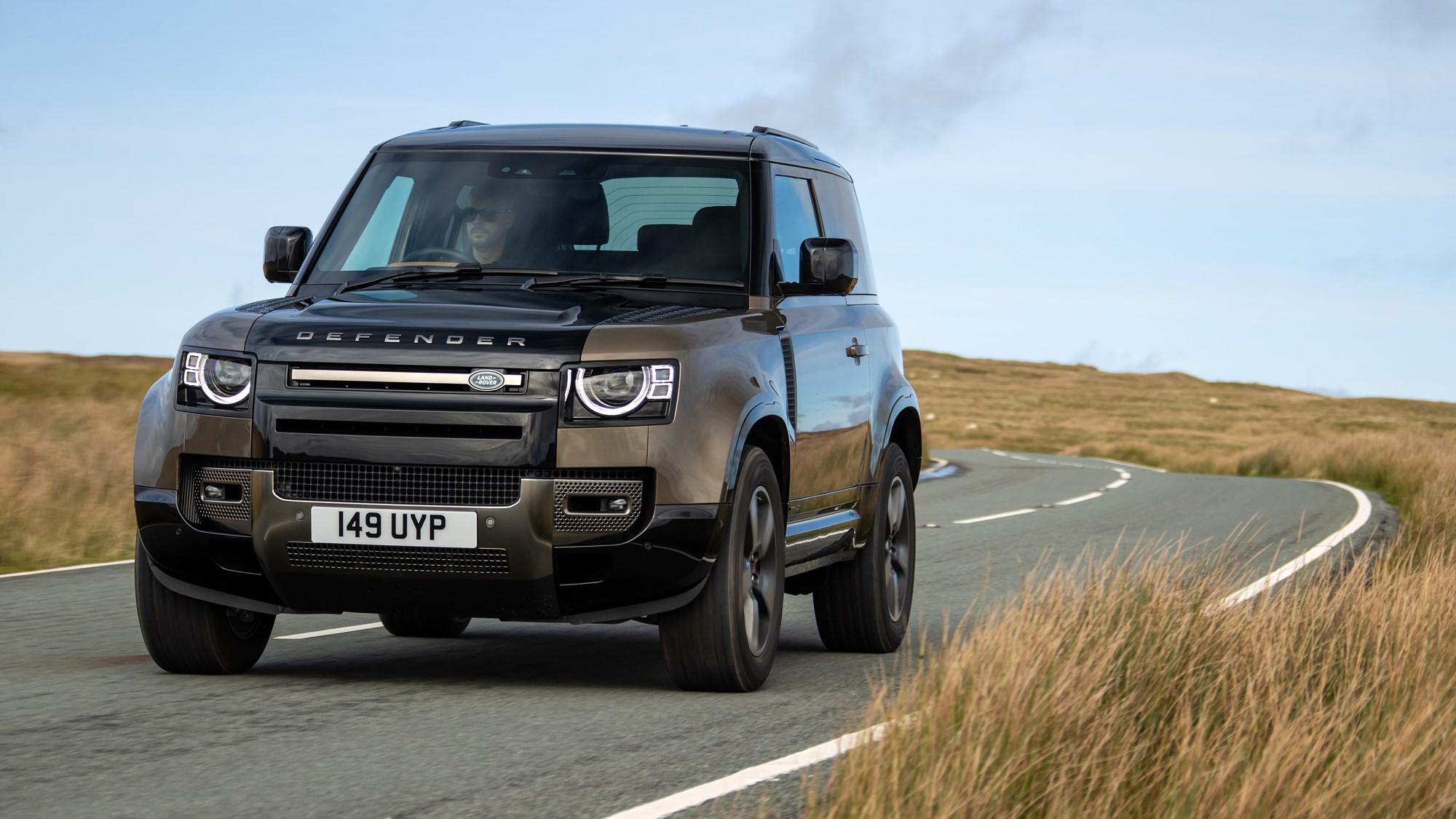
But for those who don't want to read the entire review, here's the plot-spoiling verdict summary. In material terms, Land Rover has built a new line of vehicle with all of the off-road ability you'll ever need and combined it with an impressively capable on-road package. In both respects, it's hit the bullseye... But then, you'd expect it to be better than the old one, given the last Defender was launched in 1990, itself a light facelift of the 1983 Land Rover One Ten and 1984 Ninety.
The more pertinent question for enthusiasts, is whether this one has true Defender DNA coursing through its veins. Read on to find out.
What you need to know about the new Defender
Before we delve too deeply into how it drives, it's worth catching up on a little Land Rover Defender technology. Project L663 was based on JLR's D7 Premium Lightweight Architecture (PLA) aluminium platform. But for the Defender, it's been developed into the D7X (X for Extreme) monocoque, which is claimed to be three times stiffer in terms of structual rigidity than its rivals. In real terms, that means the Defender should withstand serious loadings – reflected in its off-road ability and on-road poise.
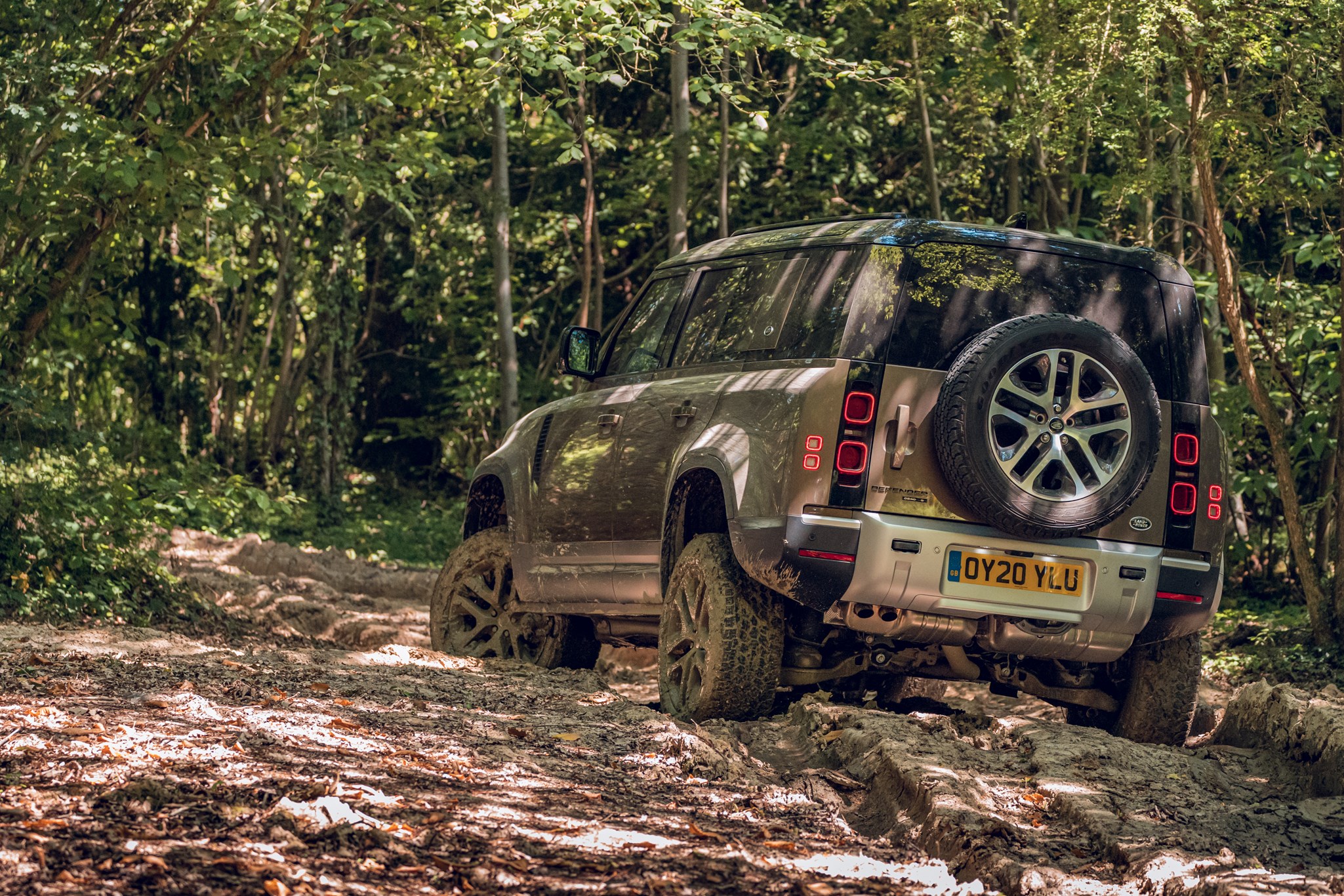
It has serious off-roading covered. Approach angles are 38 degrees front and 40 rear providing it's specced with air suspension, and it can climb a 38-degree angle and descend a 40-degree one (again on air). Wading depth is up to 900mm deep, compared with 500mm for the old Defender, while the electrical system is tested to IP67 standard – they should be able to be submerged in water for up to an hour without damage.
Off-road, the only notable difference between the short 90 and longer 110 is that the former has a ramp breakover angle of 31 degrees, but the latter's extended wheelbase reduces its figure down to 28 degrees. Still impressive, nonetheless.
There's bags of tech, too, as you'd expect. Land Rover's latest electronic architecture is significantly faster than before and now features such delights as over-the-air software updates, plus an infotainment system that's swift and responsive to use. It has 85 ECUs, and they're constantly talking to each other at up to 100Mb/s – a major step forward.
If you want a Defender, you're looking at a wait of a few months, especially if you've gone for the dinky 90 or been choosy with the configurator. That's taken as read when you consider there's the base-spec Defender, S, SE, HSE (plus X-Dynamic versions of that trio), First Edition and Defender X models to choose from. Each of those can be specced with four lifestyle packs: Country, Adventure, Explorer and Urban.
Additionally, you can choose between a 3.0-litre six-cylinder diesel with mild hybrid of varying outputs (replacing the original 2.0-litre four-pot), a 2.0-litre petrol, a 3.0-litre, six-cylinder petrol also with MHEV, plus the plug-in hybrid P400e, which also utilises the 2.0-litre mill. All are driven through an eight-speed ZF automatic transmission and dual-range 4x4. As well as that, there's an unending options list to truly personalise your Landie. Exhausting.
What's it like inside?
Inside, the Defender mixes elements of the original's functionality with the tech and equipment you expect of a modern car. There are exposed screw heads and ruggedised surfaces on the one hand, classy-looking aluminium panels on the other. It's a well-judged mix and, if anything, is a more successful new-age reboot of the franchise than the exterior. We'd fight shy of calling it premium, but it has an aura of quality with a dash of toughness. That strikes the correct balance.
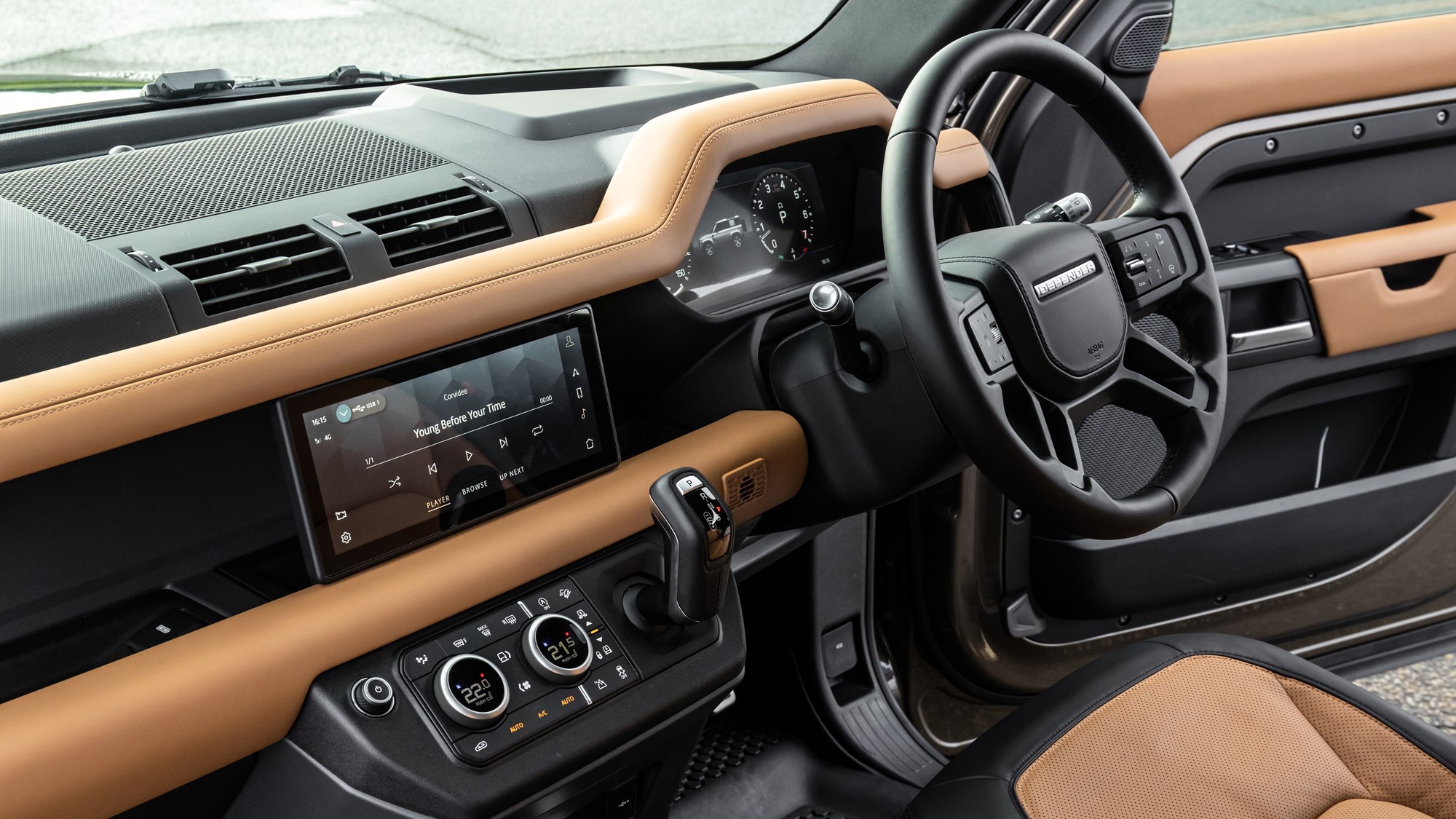
There are some very un-Land Rover Defender-like touches now, such as padded armrests and a smattering of soft-feel surfaces, as well as the joy of that optional central front seat, which you can have in place of a very capacious central storage area and cupholders. There are storage areas everywhere inside, with deep door pockets and a dashboard shelf that'll take most of your gear on the move.
The new Pivi Pro infotainment system is a cinch to use, being both quick and intuitive. It also – hooray! – syncs up and works with your smartphone seamlessly, too. No more wrestling with it to get Apple CarPlay or Android Auto to work. Other nice touches are the ClearSight rear-view mirror for when your Defender is loaded to gunwales - or you want to see what your spare wheel's obscuring - and the ClearSight camera set-up that allows you to virtually see through the bonnet via the infotainment screen for super-tough off-roading sessions.
In short, it'll be great for expeditions and is completely family-friendly, in 110 guise at least. The ruggedised interior should shrug off anything the kids throw at it, and while it's short of being hose-clean inside (when was the last Land Rover that was?) the longer Defender has a boot that'll swallow a couple of sheep, not that the mood will take you. Boot space goes from 231 litres with all three rows in place to 2233 litres with all the seats folded for the 110, 397 to 1563 litres in the compact 90.
Best 4x4s for when the going gets tough
What's it like to drive?
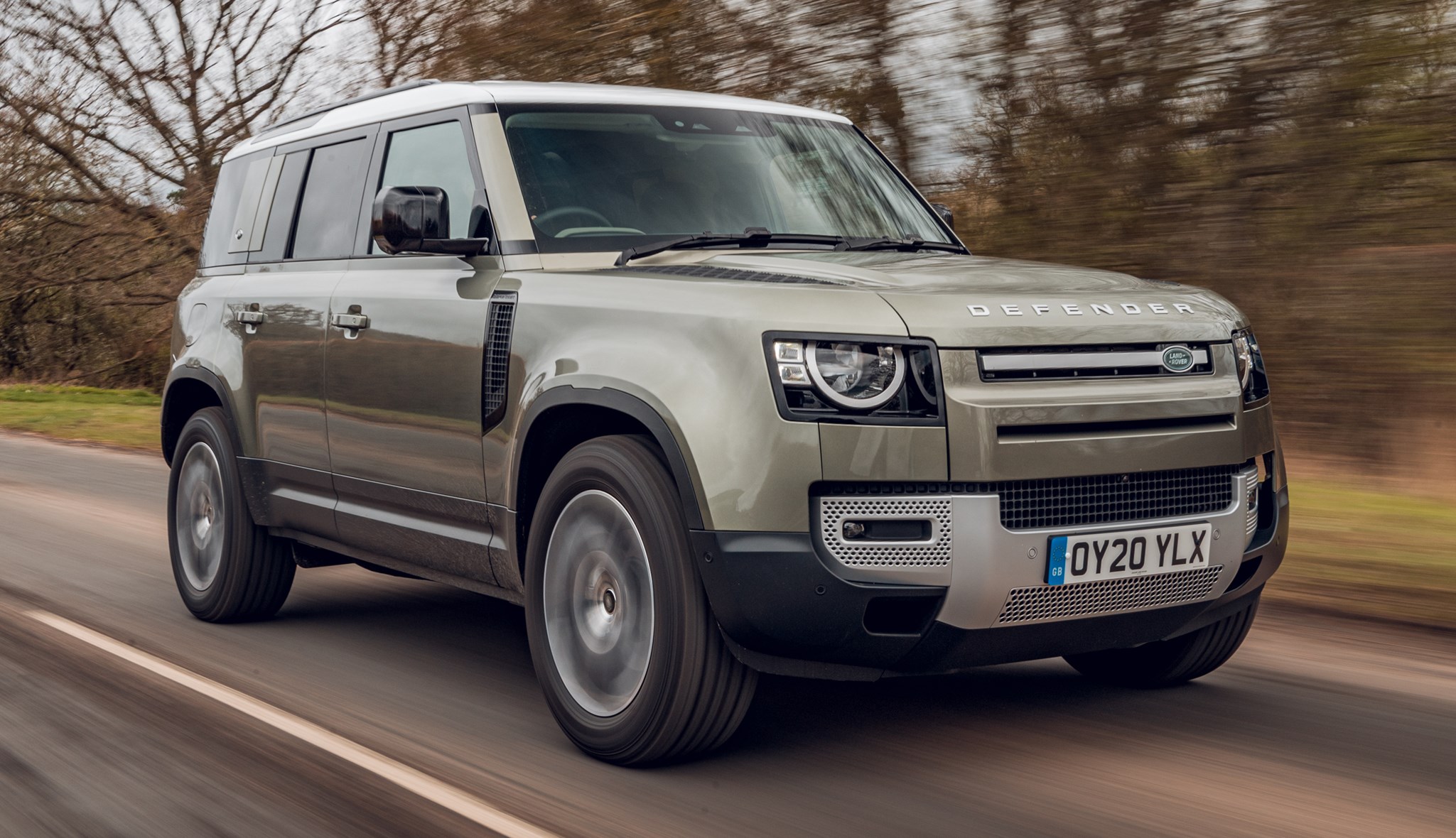
Our initial drive was of a Defender 110 D240, a model that's been discontinued for 2021, replaced by the D250. Being the more powerful of the two diesels originally on offer, there's little wrong with the way it goes – it develops 237bhp and 317lb ft – which goes a long way to overcoming its hefty 2248kg kerb weight. On paper that translates to a 0-62mph time of 9.1 seconds and a maximum speed of 117mph – but on the road, it's more than adequate.
That's the tedious issue of performance figures out of the way – but how does it actually feel on the road? A bit of a revelation, actually. The first thing that surprises is the agility of the thing, and although it's self-evidently no sports car, direct and well-weighted steering give it a positive relationship with the road, while the air suspension fitted to this model gives it a compliant ride and excellent body control. Okay, it could be argued that this is shouldn't be a Defender priority, but we're in a new world now, packed with car-based SUVs pretending to be off-roaders, and the Defender will need to swim in that pool to satisfy its owners.
Beyond that, it corners with an accuracy that will surprise you. It's easy to place, tracks bends faithfully, and we'd go as far to say as that if the road is reasonably sized, it's an enjoyable steer. Sadly, our first drive took place in the Cotswolds where the roads are cramped and packed, so we couldn't really explore too much – but it did emphasise how confidently you can place the Defender when the going gets tight.
At speed it's restful enough – there's not too much wind noise to concern yourself with, it doesn't seem to be affected by crosswinds, and the Ingenium diesel is hushed and responsive. In all, a very impressive effort, leaving us with only one question – why would you buy a full-sized Land Rover Discovery now?

What about the Defender 90?
Our on-road drive of the shorter 90 revolved around the potent P400 model, available exclusively in range-topping X specification. It weighs in at £77,400 - you have to be a committed worshiper at the church of Land Rover to not question that price tag. Leaps of faith aside, you're treated to the more refined, throatier soundtrack of a 3.0-litre straight six version of the Ingenium powertrain, complete with mild-hybridisation.
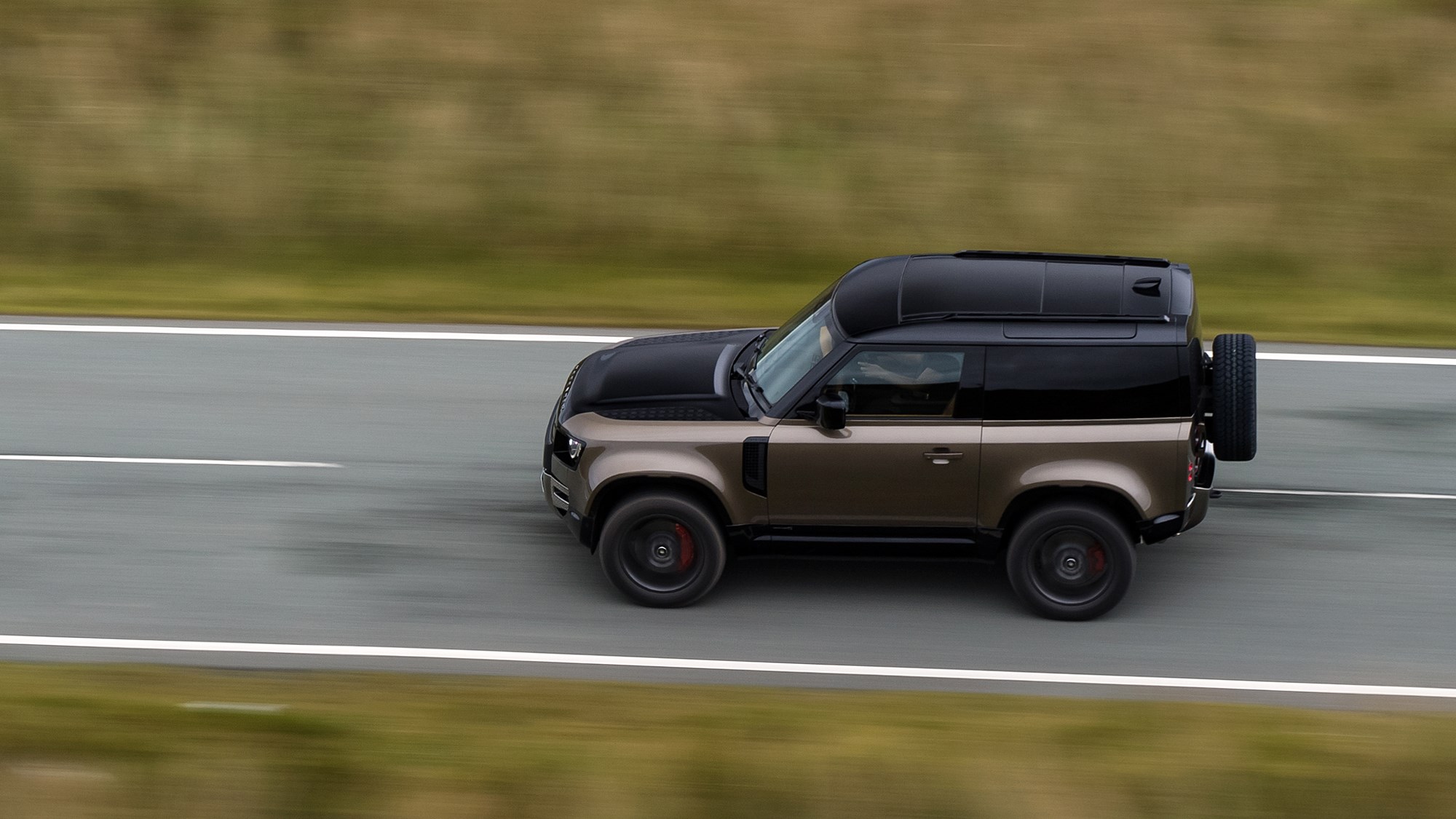
It's a very effective integration, proving seamless at slow speeds, being keen to cut the engine out as soon as possible when you're slowing for traffic lights and junctions, but more impressive is the torque surge that pushes you along when you're more liberal with the throttle application. Land Rover's figures claim that squirting from 50-75mph takes just 3.6 seconds, while the anachronistic dash from standstill to 62mph requires just six seconds flat. Remember, this is a Defender, and in this spec weighs 2268kg.
Despite its heft, tall body and short length, it handles nimbly, not feeling appreciably different on-road to the 110, although the air springs and on-board electronics doubtless dial out any twitchiness that the shorter wheelbase might otherwise introduce. Whether it's psychological or not, because you can't help but notice how short it is from the commanding driver's seat, you feel more inclined to hurl it about with vim on windy B-roads. It's a hoot doing so, or at least it is when the gap between the hedgerows is wide enough for you and a Transit van to pass each other without sucking copious volumes of air in through your teeth.
What's it like off road?
We tested both Defenders at Eastnor Castle, the home of Land Rover off-road development since the original Series model in the lead-up to its launch in 1948. The place is steeped in LR history, and as you'd expect, it was always going to perform strongly on its home turf. Full disclosure: running was conducted on all-purpose tyres and on courses purpose-built by the firm's engineers, which looked impressive, gave it a decent work-out, and comprised of rutted, muddy tracks, steep, slippery inclines, and the stickiest of mud.
The toys are all there – height-adjustable air suspension (on the 110), low-range transmission, locking centre and active rear locking diffs, all mated to the company's well-proved Terrain Response and Hill Descent technology. What this means is that Land Rover says the new Defender is more effective than any other LR product and should prove near unstoppable in the English countryside.
And so it proves. Toggle Terrain Response and Hill Descent and then just steer and go. The Defender's electronics and hardware make expert off-road adventurers out of the most hamfisted drivers. The steering, throttle and visibility leave you feeling confident that you can get from one end of the Darrien Gap to the other without real hardship – although Eastnor, we guess, could flatter to deceive. A proper off-road test will no doubt confirm our suspicions that this will live up to the Land Rover strapline, 'Best 4x4xFar'.
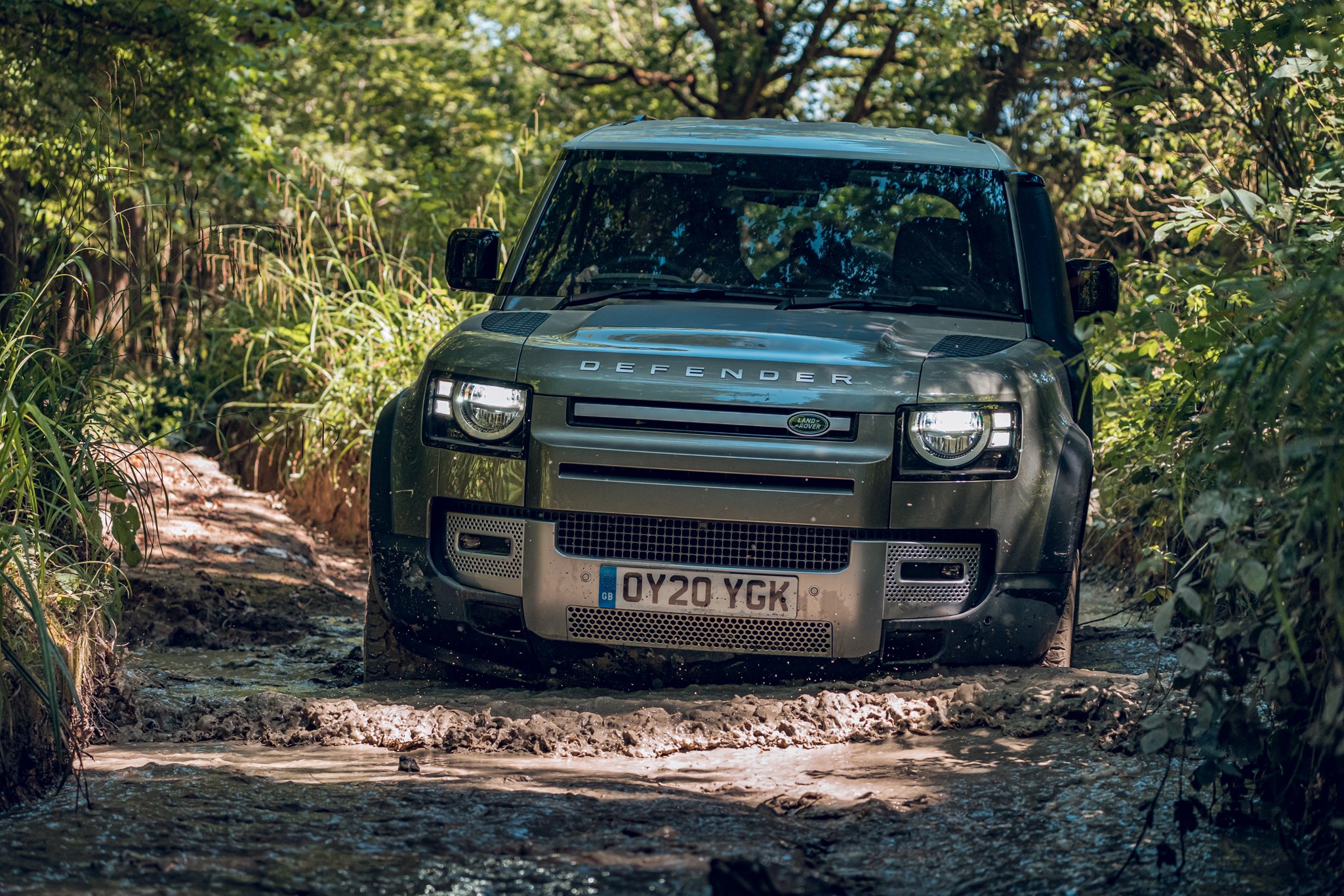
If you're serious about your off-road driving then the air spung arrangement really should be the first option box you tick, but it's demonstrative of Land Rover's belief in the Defender's abilities that when we drove the 90 on a similarly challenging course after nigh-on a fortnight of rain, we did so on the standard coil springs.
Most obvious difference between the two is that much more of the jolting from the deeply scarred trail tracks beneath are transmitted to the cabin, plus there's no option to elevate the ride height up to the air-equipped model's 291mm height where the going gets really tough, but over the course of two hours, any progress for the Defender 90 was only limited by traction in the mud - even then it got out under its own steam, without the need to be winched to safety.
Where the 90 proves slightly more adept over the 110 is that nimbless you sense on the road comes to the fore off of it, wriggling around tree stumps, boulders and earth banks with impish ease.
If you'd like more confirmation of its off-road prowess, scroll down to read Gavin Green's off-road adventure in a Defender in Namibia.
Verdict
So, the new Defenders are good. We already knew that. It is good to confirm that verdict on UK roads, not just in the countryside, but in towns and cities and on the roads that criss-cross our land. As a car to take on adventures, it certainly seems tough enough, and its off-road ability is peerless at this price point. Land Rover would never live it down if it were any other way. But most importantly, and for the toughest test of all – working out for the family – it passes with flying colours, offering space, tech and cool appeal to work on so many levels.
What it does that no Defender before has managed is to work so comprehensively well on the road. It sits comfortably on the motorway, it is playful on B-roads, and is happy in town. Specify it on air suspension, and you're invited to a world of comfort that's alien to any other Defender, while ticking the 246bhp D250 diesel box on the configurator makes it accelerate effortlessly. Not bad for the mid-range power unit.
We'll not comment on the looks – that's down to your preference – but judging from the number of heads it turned on our first drive, it looks like the UK loves it and LR has nailed it. The only thing left to do is answer the question posed at the beginning: is this worthy of the Defender badge? Based on its Swiss Army Knife approach to everything life could throw at it, the answer surely is yes – as a tough off-roader that can turn itself to anything, it really is brimming with Land Rover DNA.
But is it the vehicle that so many Land Rover Defender enthusiasts ached for? Possibly not – the affordable, rugged workhorse of old, patched together with binder twine and usually with a pair of shouty Border Collies in the back is now the stuff of legend. For those of you who don't live in the countryside, here's a newsflash: Land Rover abandoned that market years ago, leaving the working replacement for so many beloved Defenders a battered Ford Ranger or Mitsubishi L200.
It's now time to move decisively on to the next chapter of the Defender story.
So, 90 or 110? Reality is that the longer model makes much more sense for family life, with up to eight seats over three rows, a useful flat boot floor when the rearmost rows are folded away, it's easier to live with - and doubtless to sell on. The 90's more of a status car - all the more charming in its appeal as a result and will doubtless look particularly on point outside a chic London address - but the 110's more rounded.
Read on for Gavin Green's adventure drive of the the new Defender in Namibia, back in March 2020
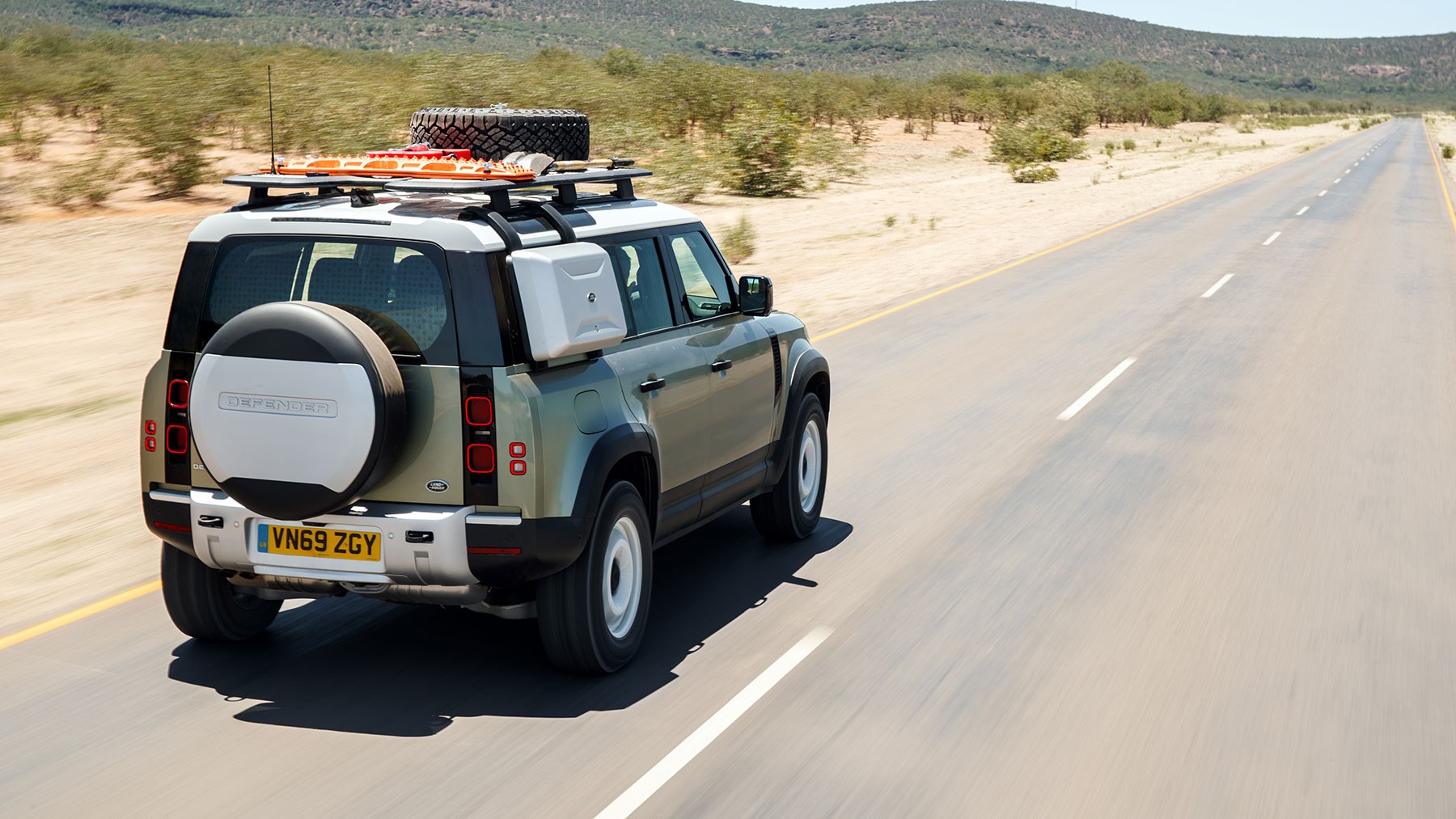
► We drive first all-new Defender in 72 years!
► The first new off-road Land Rover in decades
► Join us on a three-day Namibian adventure
Finally, after much talk and many aborted proposals, here is the new version of the car that started the Land Rover legend. And it looks unlike any other recent Land Rover. It’s a tough, chunky, boxy Land Rover that looks ready to conquer the world. The new Defender counters years of urban drift and luxury leanings from Britain’s best-known maker of 4x4s (as SUVs used to be known).
Land Rover, of course, forged its reputation in Africa. So, it made sense to undertake the new Defender’s first big adventure in the world’s wildest continent. Even better, we did it in one of the most remote parts of Africa’s most deserted country, Namibia.
Read on for our first proper new Land Rover Defender review.
Is the new 2020 Land Rover Defender a proper adventure vehicle?
It certainly looks the part with its squared styling. Off-road credentials look impressive, including low range, adjustable height air suspension (standard on the 110, as tested) and auto locking centre and rear diffs.
The best SUVs: CAR magazine's guide

The pleasingly functional design extends to rubber flooring, grab handles in the front and back, and a chunky exposed magnesium crossbeam that’s part of the dash and body structure.
Our test cars had ‘expedition’ roof racks, raised air intakes for wading rivers, roof ladders and a side-mounted ‘gear’ carrier. They used chunky mud and snow tyres. The diesel D240 had steel wheels.
I suspect these will all prove popular options in West London. They were also perfect for our Namibian adventure – a 420-mile loop in the far north-west of the country.
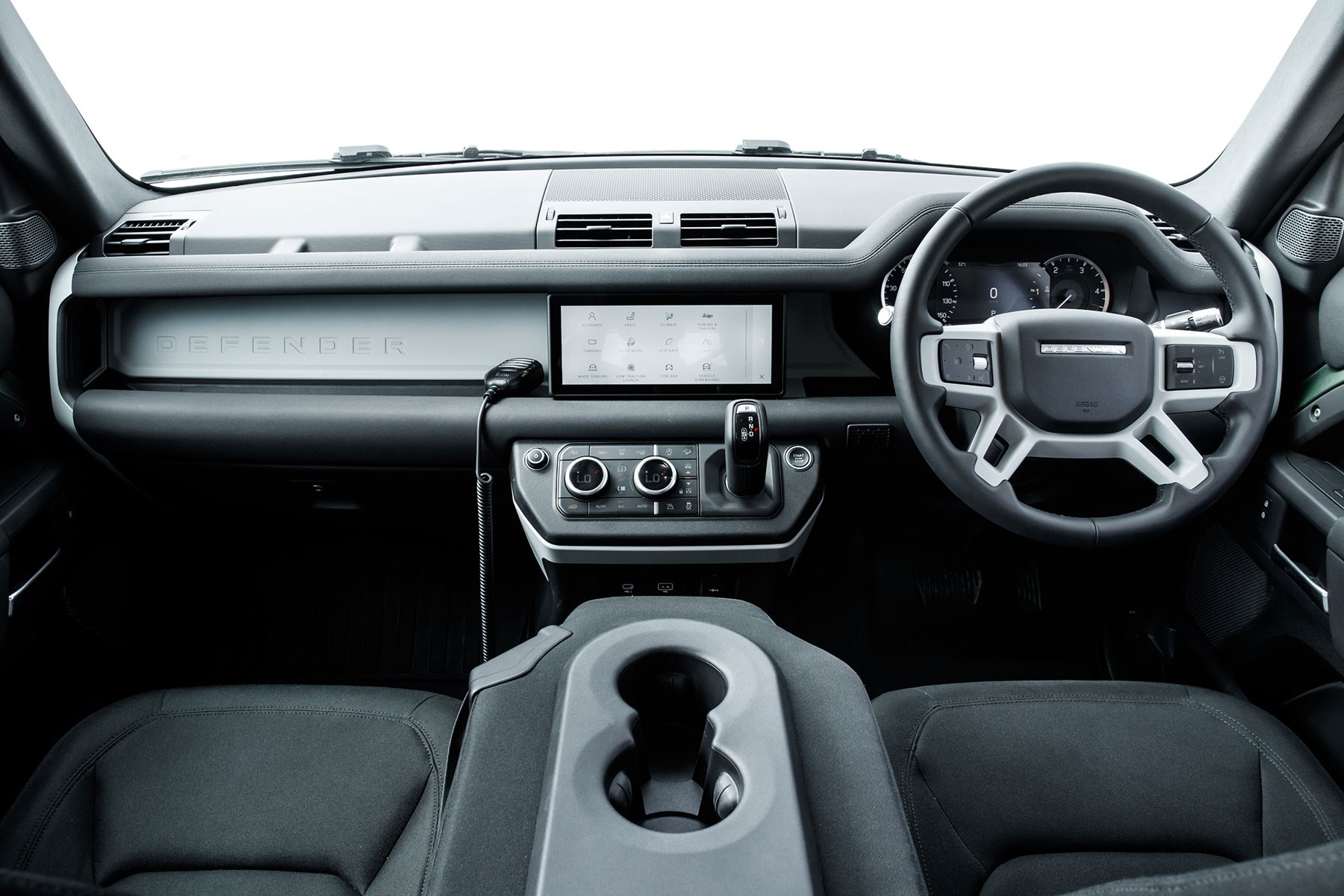
Fewer than 10 miles were on tarmac. The rest was a mix of rocky mountain passes, hard-packed sand, dunes, gravel and dry (and occasionally very wet) riverbeds.
Is it as good off-road as the old Defender?
In some areas, it’s clearly better. Wading depth is 900mm versus 500m on the old Defender (thank the height adjustable suspension). Land Rover says this is the best vehicle, off-road, it’s ever made.
More significant than the extra capability, is the ease with which the new Defender can go anywhere. Its electronically controlled 4x4 system delivers maximum grip, effortlessly. It makes it more surefooted going cautiously and more comfortable going fast. It’s easier to drive off-road than the old Landie, if less fulfilling.
The toughened D7x aluminium monocoque is the perfect platform: it's three times stiffer than the old Defender’s chassis.
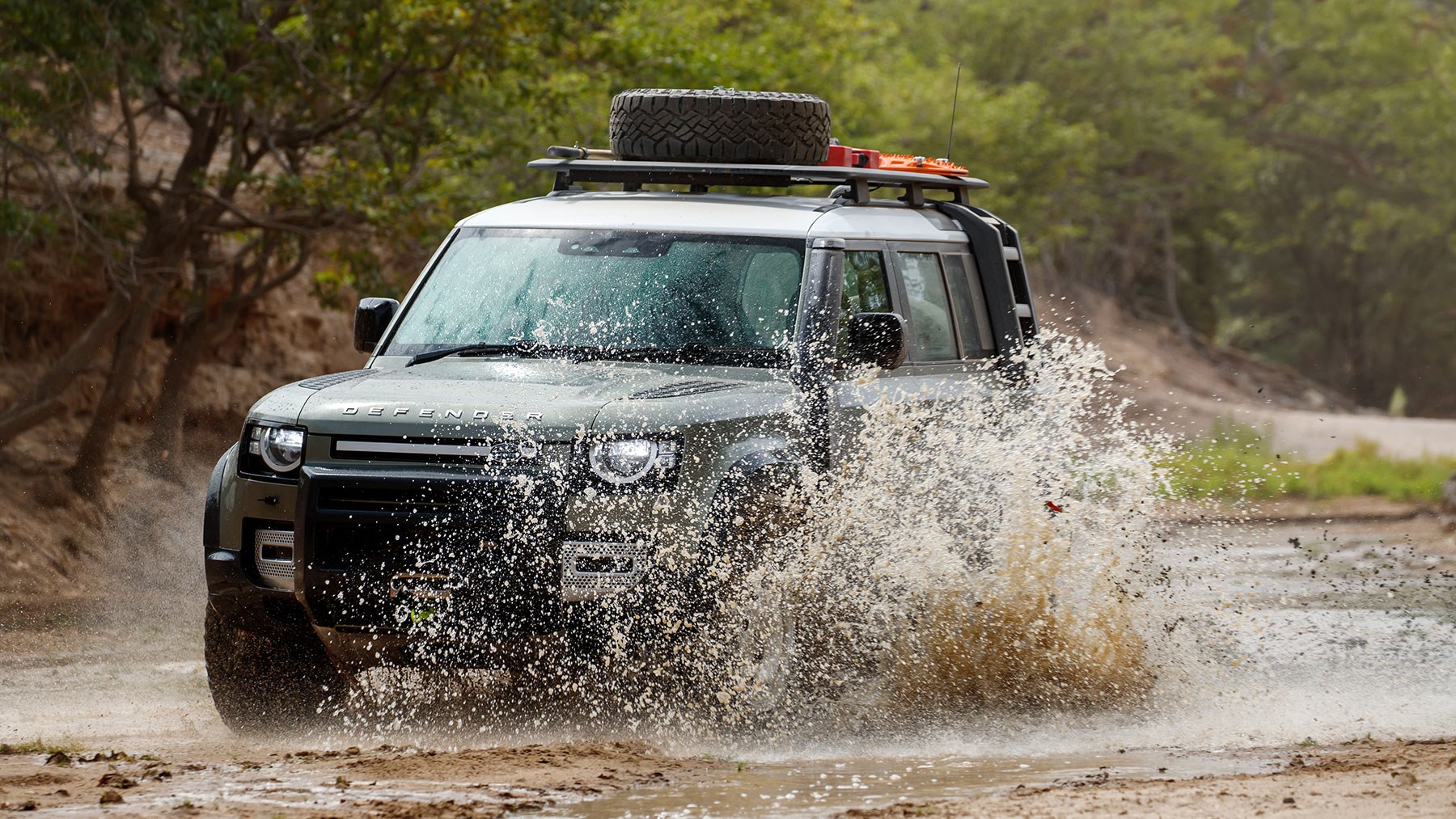
On fast gravel or sandy roads, the new car is also much faster and more comfortable. There’s none of the beam axle bounce, body-on-frame shudder or slow steering response that made the dear old Defender a very analogue, very involving but occasionally very uncomfortable drive. All-round cameras make all-terrain prowess even easier.
It’s early 2020 technology versus mid last century smithery, and it shows.
What about on the road?
The new Defender may look designed for the Serengeti rather than the city. Yet most buyers will be wealthy urbanites who live in the West or in China or Japan. That is the sad, unfulfilled fate of the modern 4x4.
Will it cope in the urban jungle? Easily. Its square style and relatively compact dimensions (the 110 is a touch longer than a BMW 3-series) make it easy to thread through town. Ride comfort is excellent. Those big air springs and vast wheel travel mean it can ride the broken urban blacktop as imperiously as the QE2 conquers ocean swells.
The ride is a little busier than a Discovery’s or a Range Rover’s and there’s more wind noise too, but it’s not excessive. On the other hand, the Defender is more fun and involving on a winding B-road than its posher brothers.
Best 4x4s for when the going gets tough
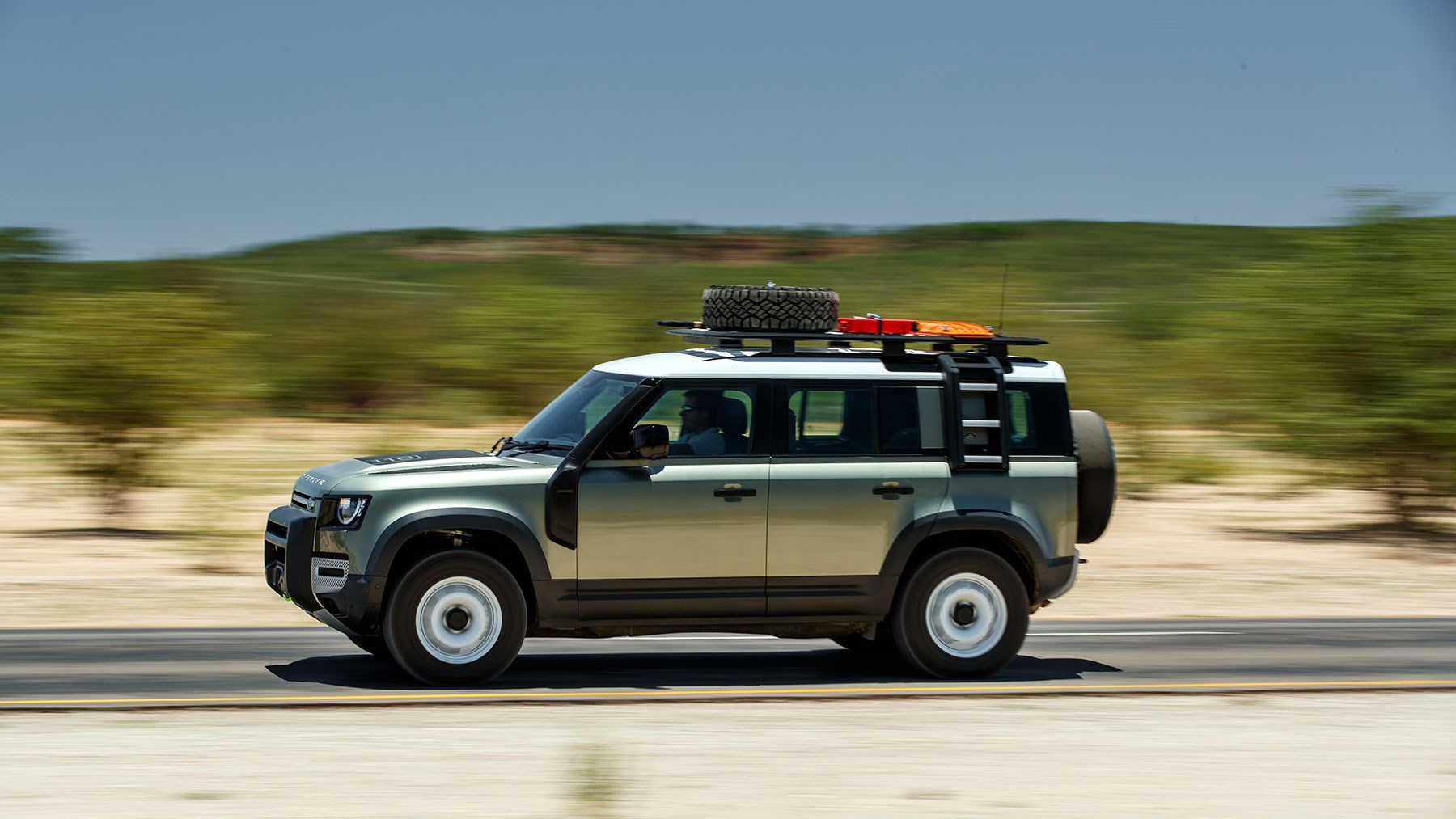
Our vehicle had the D240 237bhp diesel engine (although I also sampled the top-of-the-range P400 straight-six petrol). It's the perfect engine for the car. It’s gutsy and refined, the smoothest and quietest iteration of JLR’s Ingenium diesel to date. The torquey diesel also suits the Defender’s tough off-roader image well.
Infotainment is top-notch, the best of any Jaguar or Land Rover. It’s JLR’s new system, soon to be rolled out to posher cars. To old Defender diehards these may be the devil’s work. More important, they’ll appeal to the affluent young sporty types who JLR must target.
Verdict
Replacing an iconic 72-year old car was a tough task. In many ways, it was impossible. Land Rover has judged it well. The new Defender has all the off-roading prowess (and then some) of the wonderful old Landie and mingles that with impressive on-road comfort and everyday usability.
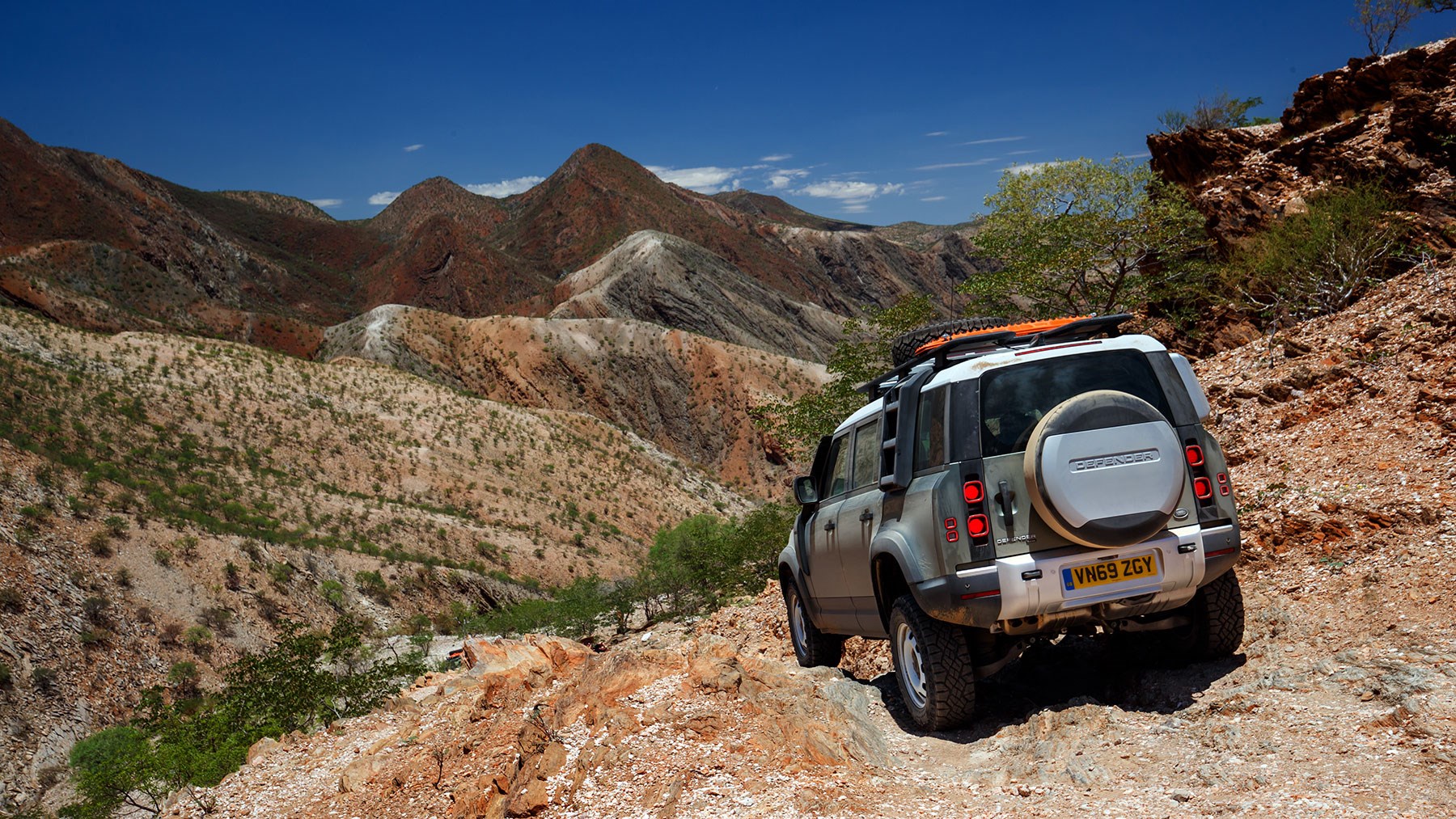
There are enough traditional styling genes to reassure the faithful and yet enough modernity to tempt those fresh to Land Rover. Whether you’re planning an African adventure or, more likely, want a utilitarian everyday car that can carry people and bikes/skis/surfboards/fishing rods/a family etc, the Defender can deliver.
It’s not cheap. Our test D240 110 cost just over £52,000. So, it’s not a working vehicle like the agricultural old Landie. It’s too pricey. The flipside is that its breadth of capability is astonishing, brilliant off-road and surprisingly refined on it. It looks and goes bush like a tough 4x4, and yet is also well suited to the monotonous family-car life of a modern SUV.
Even when motoring through Surrey or Shanghai, Silicon Valley or Sydney, there’ll still be a whiff of adventure. You can sense those Serengeti genes that continue to make the Defender the definitive 4x4. In many ways, this is Land Rover’s greatest achievement.
Read on for our earlier preview ride in the new Defender, by Ben Barry back in August 2018 as engineers conducted shakedown tests
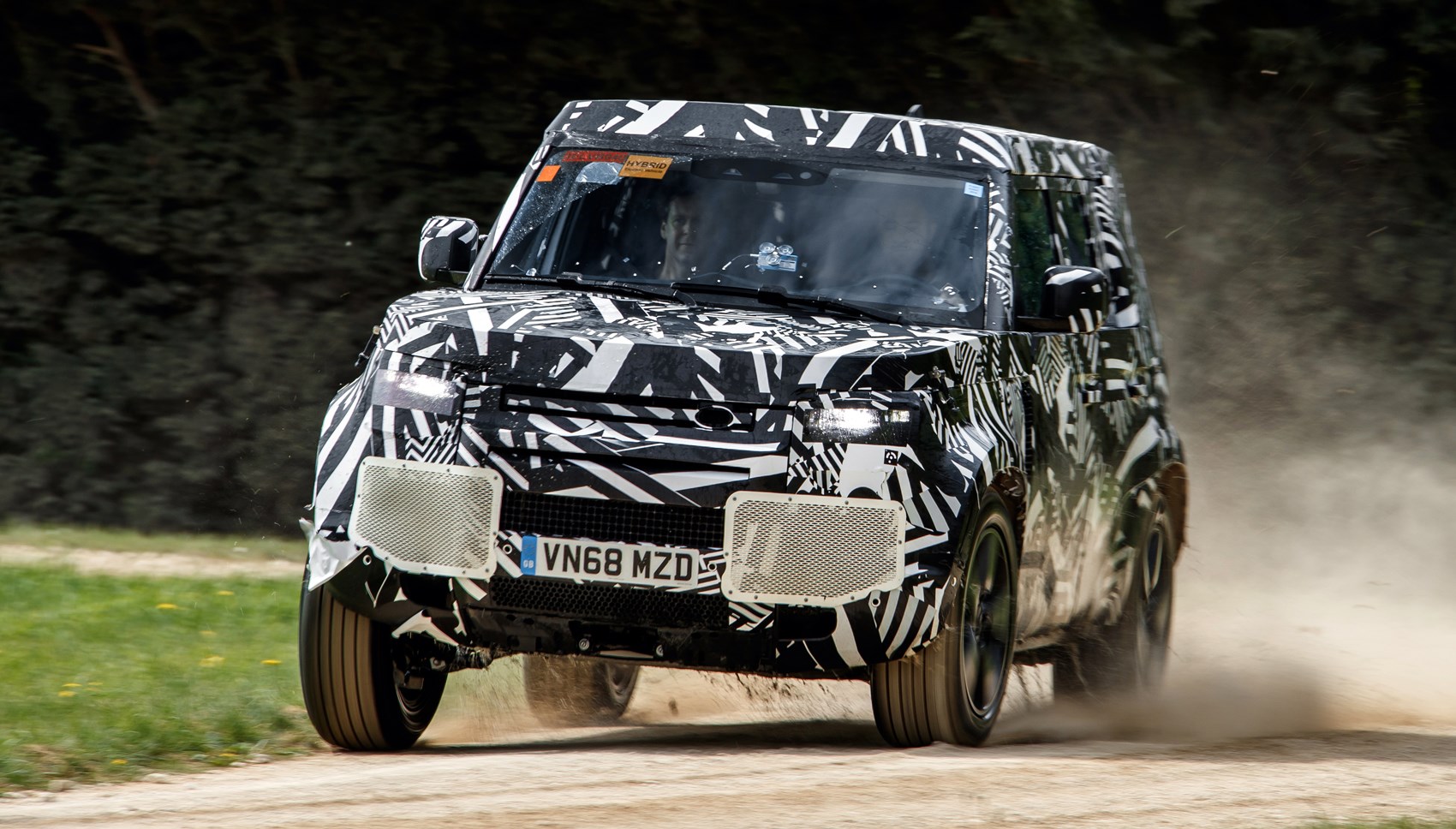
► Riding shotgun in new Defender
► What have we learned so far?
► New 4x4 hasn't gone soft
CAR was the first media outlet worldwide to hitch a ride in a prototype Land Rover Defender. We’re in the passenger seat as Andy Deeks, the new Defender’s durability and robustness programme boss, demonstrates its capabilities. Fear the Defender has gone soft? Deeks is your inside man. Land Rover isn’t just a pay cheque for him - it’s clearly a passion, and he absolutely gets why the old-timer matters.
We’re riding in a heavily camouflaged 110. It looks like a sawn-off Discovery 4 with its set-square two-box simplicity and notably short overhangs for excellent approach and breakover angles. Deeks explains that they’re still working on the wading depth, but it’ll be better than any other Land Rover on sale today, and therefore exceed the Discovery’s 900mm. That's pretty deep.
Deeks describes the new Defender test schedule as halfway between a full-size SUV programme and those used for military vehicles, making a sterner test than for any Range Rover and even the Discovery. They're keen to make sure it's tough as nails.
Keep reading for our first new Land Rover Defender preview…
Give me tech specs – what have you learned about the 2020 Defender?
The new Defender is codenamed L663 and will be based on the D7U aluminium monocoque architecture, as rolled out already for Range Rover, Range Rover Sport and Discovery with independent rear suspension and longitudinal engines. You’ll get your Defender in '90-inch' (three-door) and '110-inch' (five-door) wheelbases, though we’ll have to wait for exact dimensions, weights, off-road geometries and all those specifics. No-one is saying if they’ll bring back the 130, but the mention of '90 and 110 at launch’ is perhaps a clue.

Both air suspension and coil springs will be offered, with the former extending by up to 75mm and lowering by 50mm – air will give the best off-road performance, coils the cheapest point of entry, though you can imagine the simplicity of coils appealing to those wanting a rugged workhorse.
There’s permanent all-wheel drive, a standard low-range transfer case, three auto-locking diffs (front axle, centre and rear axle), with the hardware depending on each engine spec (if ‘not affecting capability’, as Deeks puts it), and a choice of 18-22-inch wheels with all-terrain tyres as standard, though 21s are left off the menu and more aggressive off-road rubber will also be available up to 20 inches.
Want a look inside? The Defender’s dashboard and door casings are draped with fabric to thwart prying eyes, and the (unrepresentative) four-spoke steering wheel is disguised to look like a three-spoker. We’ve already papped a Defender’s interior here.
What did you experience as a passenger?
The rough dirt road we’re driving on wouldn’t come close to troubling an old Defender’s off-road prowess, but one thing is immediately obvious: how serenely the new Defender sails over the pockmarked surface, and how casually Deeks can twirl at the electrically assisted steering. The old car would rattle and shake, its slower steering would demand more work, but bar the odd thunk in the really gnarly stuff, the new Defender mostly glides over the bumpy surface.
As you’d expect, Deeks says the 110 rides more comfortably and is more stable thanks to its longer wheelbase, while the 90 has the better off-road capability, ‘purely down to its geometry.'
The speed at which the new Defender can cover rough ground places even greater demands on durability. ‘It’s given us a bit of a headache to be honest,’ admits Deeks, ‘because the more capable and refined the vehicle, the faster people are going to drive, and the more durable it has to be - so all our durability targets and standard requirements have been uplifted.’
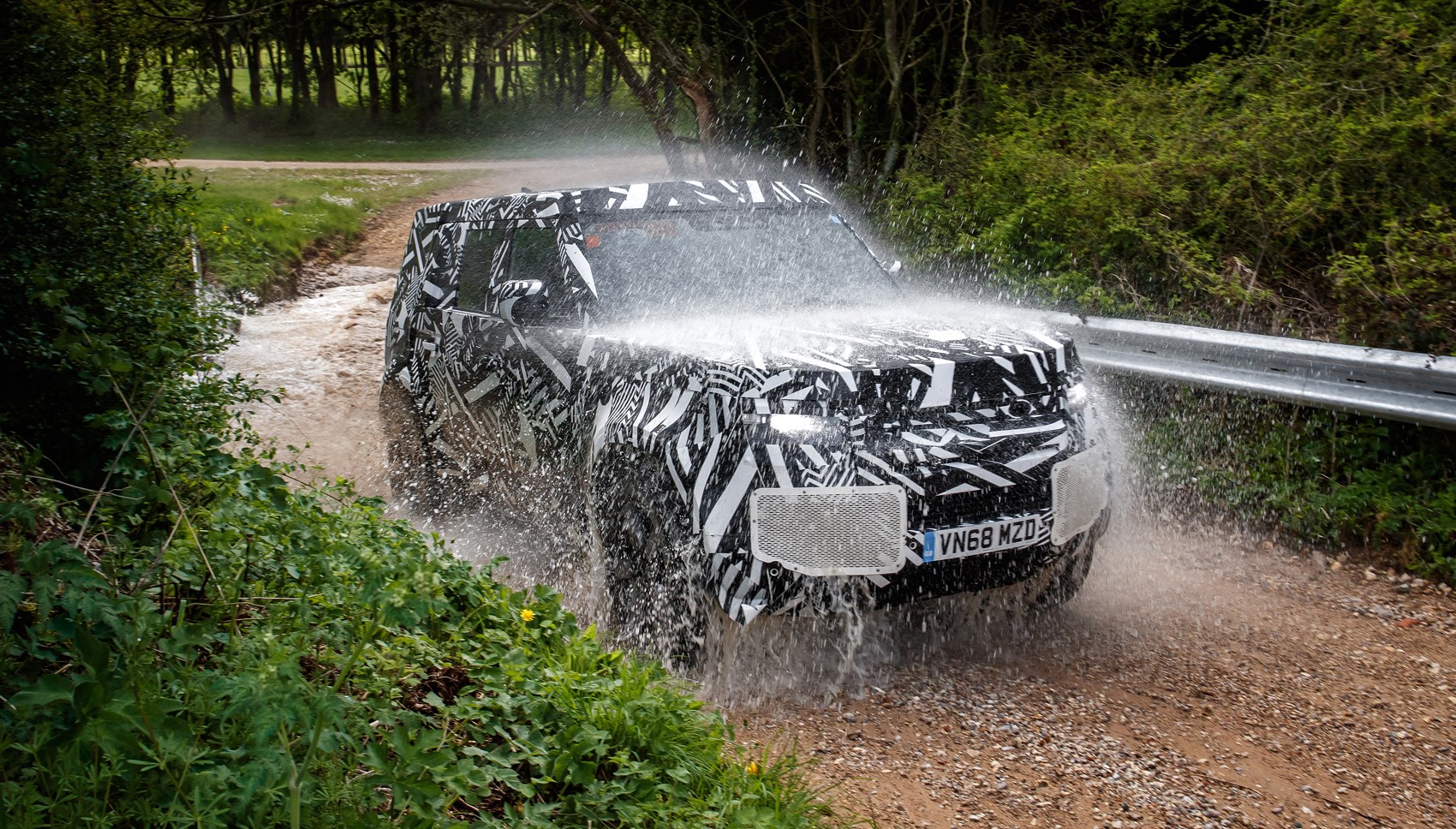
When asked where they’ve gained the most, on-road or off-road, without hesitation Deeks replies there are leaps across the board. ‘Versus the old car there are huge improvements in NVH [noise, vibration and harshness], off-road capability and on-composure, but without losing that core DNA of Defender,’ he says. The Defender certainly handles the ragged B-road section of our test very ably, feeling composed and comfortable where an old Defender would shimmy, bounce and clatter.
Notably, this is the first Defender to be tested at the Nürburgring. And that tells you a lot about the changing brief for next decade's new Landie.
We’ve had the standard Terrain Response system in Auto for the entire drive, and as we pass over one particularly fragmented if very short section of tarmac, it feels like the road surface has changed, only it hasn’t – the continuously variable dampers have quickly processed the surface, and adapted to smother the ripples.
New Land Rover Defender: first impressions
It’s impressive, but much work remains to be done. At the time of our ride in late April 2019, some 200 test hacks had covered around 750,000 miles.
We’ll be putting the production Defender through its paces as soon as we can after its debut later in 2019, but on this early prototype evidence it certainly looks like there are large objective gains, both on- and off-road. Undoubtedly diehards will understandably continue to mourn the old body-on-frame icon, but it must make the new Defender’s debut a little easier to stomach knowing someone as passionate as Deeks is helping guide its replacement’s development.
View Land Rover Defender lease deals
Check out our Land Rover reviews